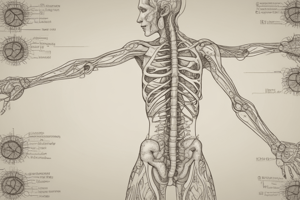Podcast
Questions and Answers
Which of the following is NOT a characteristic of the Autonomic Nervous System (ANS)?
Which of the following is NOT a characteristic of the Autonomic Nervous System (ANS)?
- Contains pre- and post-ganglionic fibers
- Effects mainly smooth muscle, glands, and cardiac muscle
- Directly affects skeletal muscle (correct)
- Rapidity and intensity
Which of the following is the main location of the ANS centers that activate the autonomic nervous system?
Which of the following is the main location of the ANS centers that activate the autonomic nervous system?
- Pons
- Spinal cord, brain stem, and hypothalamus (correct)
- Cerebral cortex
- Cerebellum
What is the term for the phenomenon where most viscera receive nerve fibers from both the sympathetic and parasympathetic divisions?
What is the term for the phenomenon where most viscera receive nerve fibers from both the sympathetic and parasympathetic divisions?
- Somatic dominance
- Dual innervation (correct)
- Single innervation
- Autonomic integration
Which of the following spinal nerves are involved in the sympathetic nervous system?
Which of the following spinal nerves are involved in the sympathetic nervous system?
What is the neurotransmitter released by the post-ganglionic neuron in the parasympathetic nervous system?
What is the neurotransmitter released by the post-ganglionic neuron in the parasympathetic nervous system?
Which of the following cranial nerves is NOT involved in the parasympathetic nervous system?
Which of the following cranial nerves is NOT involved in the parasympathetic nervous system?
What percentage of all parasympathetic nerve fibers are found in the vagus nerves?
What percentage of all parasympathetic nerve fibers are found in the vagus nerves?
Which of the following is a function of the Somatic Nervous System?
Which of the following is a function of the Somatic Nervous System?
Study Notes
Autonomic Nervous System (ANS)
- Controls visceral functions of the body, including:
- Arterial pressure
- Gastrointestinal motility
- Gastrointestinal secretion
- Sweating
- Body temperature
Characteristics of ANS
- Rapid response (within 3-5 seconds) and intensity
- Can increase heart rate to twice normal within 3-5 seconds
Effect of ANS
- Mainly affects:
- Smooth muscle
- Glands
- Cardiac muscle
Comparison with Somatic Nervous System (SNS)
- SNS only affects skeletal muscle
- SNS effects skeletal muscle directly via motor nerve
Centers and Effects of ANS
- ANS centers located in:
- Spinal cord
- Brain stem
- Hypothalamus
- Two major subdivisions of ANS:
- Sympathetic Nervous System (SNS)
- Parasympathetic Nervous System (PNS)
Sympathetic Nervous System (SNS)
- SNS originates in:
- Thoraco-lumbar spinal cord (T1-L2)
- Short pre-ganglionic fibers from spinal cord synapse with:
- Paravertebral ganglions (close to spinal cord)
- Prevertebral Celiac or epigastric ganglion
- Long post-ganglionic fibers then send signals to affected side
Neurotransmitters and Receptors of SNS
- Pre-ganglionic nerve secretes:
- Acetylcholine (Ach)
- Post-ganglionic neuron secretes:
- Either Acetylcholine (Ach) or Norepinephrine (NE)
Parasympathetic Nervous System (PNS)
- PNS originates from:
- Cranial nerves (III, VII, IX, and X)
- 1-4 sacral spinal nerves
- About 75% of all parasympathetic nerve fibers are in the:
- Vagus nerve (cranial nerve X)
Studying That Suits You
Use AI to generate personalized quizzes and flashcards to suit your learning preferences.
Description
This quiz covers the autonomic nervous system, its characteristics, and effects on various muscle types and glands. Study the ANS' role in controlling visceral functions, heart rate, and more.




